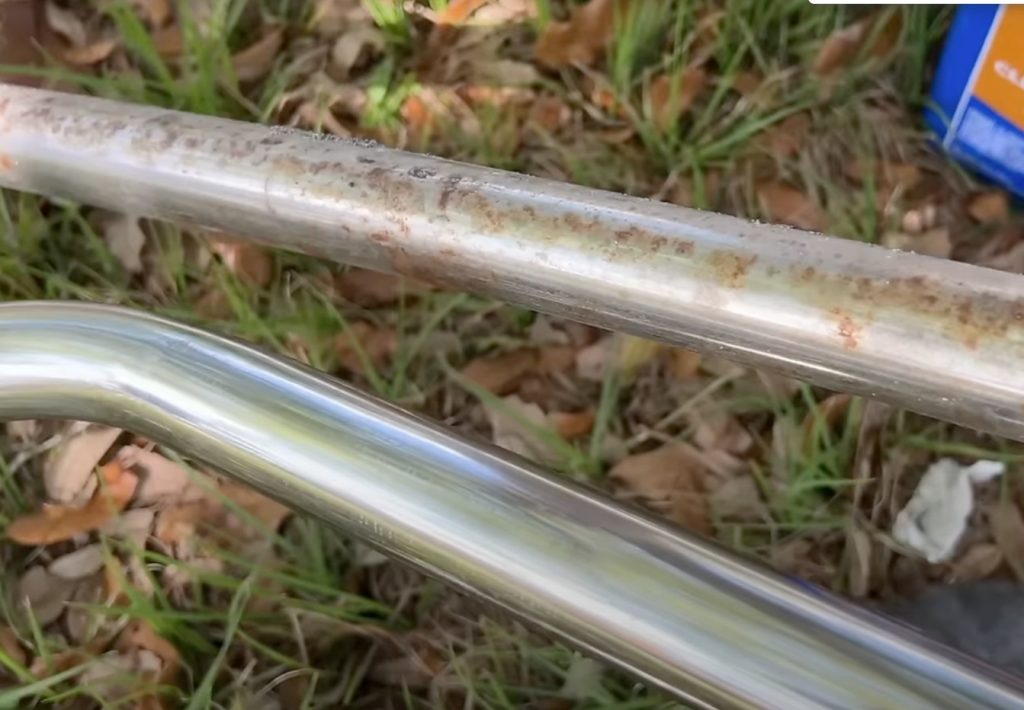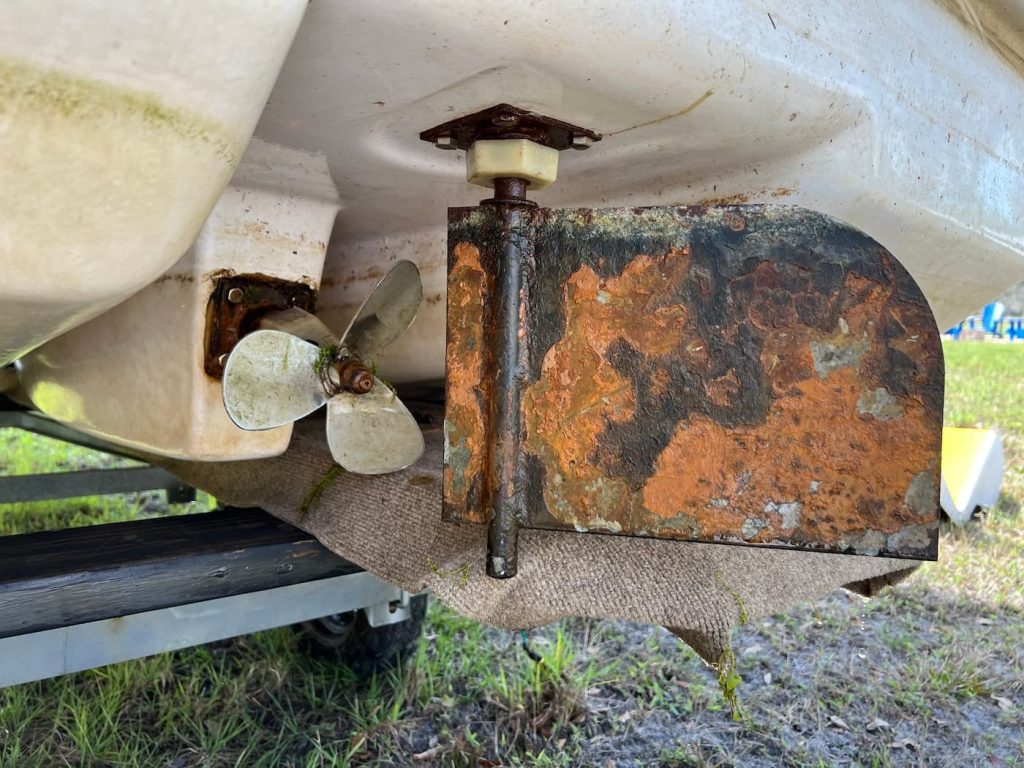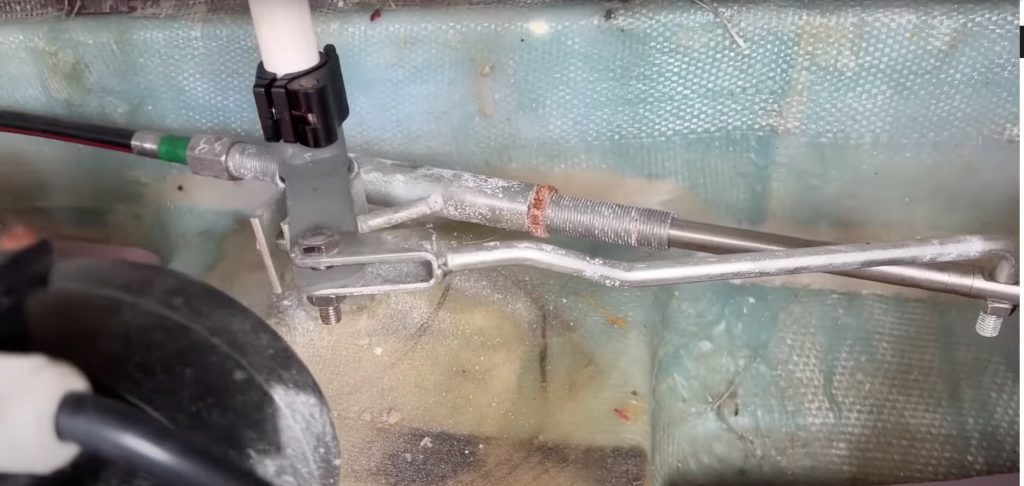
My regular readers may remember that two years ago, I was winning so hard at life that I bought myself a brand-spankin’ new boat as a treat. Don’t get me wrong, I’m still on an independent journalist’s salary here though, so when I say that I had “boat money”, I mean I scraped together enough to buy a $1,000 electric boat directly from China. It’s now been two years since that Alibaba delivery, so let’s see how it’s held up and what it looks like now.
As a bit of a refresher first though, here’s what I got at the time. Inside of a surprisingly well-made steel frame and plywood-lined crate (that probably would have cost $1k by itself to have made in the US), my five-seater fiberglass boat awaited me.
It was powered by a cute little 500W inboard motor with a belt and pulley drive connecting it to a rudimentary prop fashioned out of 1/8″ (3mm thick) steel plate bent and welded onto a section of pipe.
The boat didn’t have batteries, so I added my own pair of 12V 200Ah LiFePO4 batteries to create a 5 kWh battery pack that was likely way bigger than I needed.
You can check out my unboxing and testing video here, which went viral with nearly four million people having now joined me at the beginning of this crazy adventure.


The boat seemed to work, in that it stayed above the waterline of our local lake and could move both fore and aft under its own power, fulfilling the major requirements of what it takes to be a motorboat.
However, its performance left a lot to be desired. The prop was only around 75% submerged, meaning there was a lot of cavitation and wasted power churning air through the water. Not only did that make it inefficient, but also slow.
It was hard to travel over a single knot, though I did briefly hit 2 knots on my GPS speedometer app (and I’m counting that, even if I can’t be sure it wasn’t a fluke).
In other words, the boat was surprisingly decent, yet the performance was underwhelming.
For a while now, I’ve been chipping away at a few upgrades to the boat each time I visit my parent’s house, where I keep it. It’s been a fine little boat for my dad to take the grandkids out on and teach them about boating, but it has been due for some deferred love, maintenance, and upgrades.


First of all, here’s how it has aged. Without regular cleaning, there was some serious marine grime building up, but the fiberglass has actually held up surprisingly well in two years of harsh Florida sun and UV.
After two years, the chrome railings had a decent amount of corrosion and what looked like pitting, though it pretty much all buffed right out when I disassembled the canopy to clean everything really well.
After buffing the shine back into the rails, I applied a clear coat so that the rails will hopefully keep their shimmer and I won’t have to re-scrub the life back into them next year. The rest of the boat’s hull and canopy got a simple soapy scrub down.
As I put the canopy back together, I finally made a big addition I’ve been planning ever since I got the boat: solar panels. I put a pair of 100W solar panels on the canopy and wired them into an MPPT solar charge controller that feeds back into the batteries. The panels don’t charge quite as quickly as the boat drains, but it has meant that I never need to pull the boat out to charge it anymore since it just slowly charges up all day while it’s floating around at the dock.
Solar panels on electric boats are a game changer, especially those used for only a few hours a week, such as a Sunday cruise. You can run your battery nearly empty on the water in a day, then let it charge itself up over the next few days.


The next big upgrade I’ve been planning is more power. To get there, I had a slick idea that would let me replace the old rudder and motor in one fell swoop.
The rudder was horribly rusted out at this point, though amazingly that terribly inefficient propellor looked nearly as good as new, so I suspect they actually used stainless steel to fabricate it.


Since the design of the propellor shaft meant that its angle forced the propellor to be too high, I decided to simply replace that entire system with an alternative. Instead of yanking out the propellor shaft and needing to seal the stuffing box, I left the existing seals in place and just cut off the propellor. It ain’t pretty, but it’s below the waterline. It was also a rare case of the easiest solution and the safest solution converging on the same answer, since the shaft is already perfectly sealed against water ingress.
I found an 80 lb thrust Minn Kota trolling motor used online and snagged it for around $200 (it cost over $1,400 new for this American-made motor). It has what Minn Kota refers to as an indestructible shaft, which I believe since it was hard as hell to cut it down to length using a pipe cutter, which was necessary to preserve the wires that run down the shaft.
I removed the rudder and replaced it with the entire trolling motor, now with its shortened shaft, and welded up some new linkage to connect it to the old rudder controls. After yanking out the Minn Kota’s control board and wiring it into my batteries, I had a Frankenstein setup that I figured would give me much more power and also some effective thrust vectoring since I could control the direction of the motor from the wheel, like a real outboard.




I hadn’t yet run the wires up to the helm, so the boat temporarily required a crew of two when I put it back into the water. My dad took the wheel while I stayed in the ‘engine room’ in the back to control the throttle.
It was immediately apparent how much more powerful the boat was now, actually leaving a wake. Unfortunately, it was also immediately apparent why boats have rudders, since this flat bottom boat now had the worst case of oversteer I’ve ever seen.
With the powerful thrust, the boat basically shoved its ass-end all over the place with just a bit of nudging. The cool thing was that it could literally turn in its own length, though we were basically always turning until we could find neutral on the wheel.
My dad described what we had done as “like putting an outboard motor on a pie tin”, and I have to say that felt pretty accurate. It made for some great laughs (see the testing video here, highly recommended!) but was barely controllable. It felt like a bumper car on water.

To fix it, I added a simple bolt-on rudder on the motor shaft. Putting the boat back in proved that there was more control, but it still tends to oversteer a bit. Don’t get me wrong, it’s fun as hell, but it’s still doesn’t have the precision control I was hoping for. Oh well, it’s good enough for a $1,000 Chinese boat with nearly half as much added into it as part of the upgrades!
Now, the boat is solar-powered, so it never needs charging, and the power is much better to allow for some actually fun cruising at speeds of up to approximately 5 knots. I don’t think we’ll be pulling a water skier anytime soon, but we’re definitely leaving a wake now.
The last thing I need to do is add a pair of bilge pumps (it’s got two sponsons that create low points on either side, so I need two pumps). I had been putting off that project because I never thought I’d really need them, and it was more of a precaution in case of some type of freak accident where I rammed something submerged that holed the hull. I was also dreading putting a hole in a perfectly good fiberglass boat for the pump outlet, even if it was going to be well above the water line.
However, what I didn’t account for was Hurricane Milton, which put so much rain into the boat at such a steep angle that it actually started working its way under the rear bench and filling up the “engine room” area below deck. The boat is self-bailing, at least in normal rain, and has a central scupper that funnels rainwater down through the hull. With around a foot (30 cm) of freeboard, it’s never been an issue, even in hard Florida rains. But a Cat 3 hurricane is a different animal, and once enough water worked its way under the rear bench and the sideways wind/rain duo started tipping the boat, physics took the wheel and the below picture is how things looked after the storm passed.

Top comment by Sergey Solyanik
I absolutely love these series! Much more interesting than "here is a new Chinese car we will never see in the US" articles.
Minor nits: propellEr is spelled with E, not O, and cavitation is forming water vapor filled bubbles because the propellEr moves too fast, faster than water can move into the void formed by rotating blades, not gulping air from the surface.
Fortunately, this was pretty much the only damage my parents’ place took. The boat had probably 100 gallons 380 liters) of water below deck and so my dad couldn’t right it by himself. It sat that way for around six weeks until my next visit, when we pumped the water out. The hull was still secure and she floated right back to her former self.
Having survived two years of use and a Category 3 hurricane, it was time to finally give the old girl’ a name. I asked my subscribers for their recommendations and received hundreds of great ideas (including dozens of Boaty McBoatface) but finally decided on what I felt was the best name of all.
As you read this, the Sunny Side Up still floats, basking in the battery-charging sun and cruising the local private waterways at speeds fast enough to get a fist shaken at you in a no-wake zone.
She ain’t the prettiest boat out there. Nor the fastest. But she’s mine, and she’s beautiful to me.

FTC: We use income earning auto affiliate links. More.





Comments